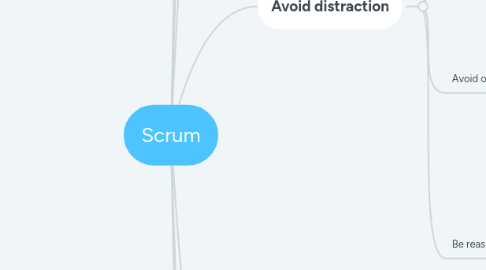
1. Why Trying Scrum?
1.1. Waterfall problems
1.1.1. Gantt Charts
1.1.1.1. Popular
1.1.1.2. Color-coded parallel bars
1.1.1.3. Timing and length
1.1.1.4. May occur simultaneously
1.1.1.5. No degree of importance
1.1.2. Fall behind schedule
1.1.3. More resources involve
1.1.4. Bad results
1.2. Case study from FBI
1.2.1. Project "Virtual Case File": Share information and prevent another 9/11.
1.2.2. Deadline for every important milestone
1.2.2.1. "Technical design” phase
1.2.2.2. “Coding and testing” phase
1.2.3. Broke down before a single line of code was written
1.2.4. Tons of time and $170 million wasted
1.2.5. Applied Scrum and success
1.2.5.1. Less time
1.2.5.2. Fewer people
1.2.5.3. Lower cost
1.3. What Scrum is
1.3.1. Rugby
1.3.1.1. Works together to move the ball down the field
1.3.1.2. All united by the same clear goal
1.3.2. Team building
1.3.3. Constant feedback
2. Launch a Scrum project
2.1. Pick a Product Owner
2.2. Choose a team
2.2.1. Five to nine people per team
2.2.2. Encompass all the skills needed for the project
2.3. Pick a Scrum Master
2.3.1. Responsible for coaching
2.3.2. How to work together effectively
2.3.3. Maintain good Scrum techniques
2.4. Create the Project Backlog
2.4.1. List of tasks you’ll need to complete
2.4.2. Highest value and the lowest amount of risk to the top
2.4.3. How
2.4.3.1. Which tasks have the biggest business impact?
2.4.3.2. Which are most important to the customer?
2.4.3.3. Which will earn the most money?
2.4.3.4. Which are easiest to complete?
2.5. Make sure that everything is Doable in Sprints
2.6. Host the first Scrum meeting and plan the first Sprint
2.7. Create a Scrum Board
2.8. Daily Stand-Up meetings help everything run smoothly
2.9. Sprint Review
2.9.1. Demonstrate something usable
2.10. Sprint Retrospective
2.10.1. Define improvements
2.11. Next Sprint!
3. Product Owner
3.1. Characteristics
3.1.1. Knowledge of their particular market
3.1.2. Authority to make decisions without interference from management
3.1.3. Availability to explain what needs to be done to team members
3.1.4. Accountability for the final product, or for how much revenue is produced
3.2. OODA loop
3.2.1. Make decisions based on real-time feedback
3.2.2. Observe
3.2.2.1. Start the process by seeing where you are
3.2.3. Orient
3.2.3.1. evaluate how to create more possibilities
3.2.4. Decide
3.2.5. Act
4. Avoid distraction
4.1. Avoid multitasking
4.1.1. Waste time
4.1.2. Waste energy
4.2. Using what you’ve created
4.2.1. Waste effort
4.2.2. Waste money
4.3. Fix your mistake immediately
4.3.1. Remembering all the different factors that caused the bug
4.3.2. Waste tons of time
4.4. Avoid overworking
4.4.1. Overload
4.4.1.1. Low energy
4.4.1.2. Make bad decisions
4.4.1.3. Mess up
4.4.1.4. Distract others
4.4.2. Boosting productivity
4.4.2.1. Working fewer hours
4.4.2.2. Taking vacations
4.4.2.3. Happy
4.4.2.4. Improve the quality of work
4.5. Be reasonable
4.5.1. Setting impossible goals
4.5.2. Waste employee’s motivation
5. Teamwork
5.1. Create an effective project management
5.2. 4 Changes for greater teamwork
5.2.1. How team members going to reach objectives
5.2.1.1. Responsibility
5.2.1.2. Autonomy
5.2.2. Make sure your team has a broader purpose
5.2.2.1. Staff’s expectations
5.2.2.2. Same common goal
5.2.3. Self-sufficient teams
5.2.3.1. It’s about the final product
5.2.3.2. Diversity in skills, thinking and experience
5.2.4. Reducing teams size
5.2.4.1. Better communication
5.2.4.2. What everyone else doing is
6. Sprint
6.1. What
6.1.1. Short periods of work
6.1.2. Focus on a specific task
6.1.3. Review progress and refine goals
6.2. Why
6.2.1. Better time management
6.2.2. Respond to problems quickly
6.2.3. Re-calibrate the objective
6.2.4. Spends months for shit
6.3. How
6.3.1. A consistent working rhythm
6.3.1.1. One task per Sprint
6.3.1.2. Concentrate effectively
6.3.2. Daily Stand-Ups
6.3.2.1. What did you do yesterday to help the team finish the Sprint?
6.3.2.2. What will you do today?
6.3.2.3. What obstacles are you facing?
6.3.2.4. No more than 15 minutes.
7. Boosting productivity
7.1. Connection
7.1.1. Training
7.1.2. Learning
7.1.3. Growth
7.2. Visibility
7.2.1. Secrecy is toxic
7.2.1.1. Suspicion
7.2.1.2. Mistrust
7.2.1.3. Lower motivation
7.2.1.4. Damage performance
7.2.2. Scrum board
7.2.2.1. Backlog
7.2.2.2. To-Do
7.2.2.3. In Progress
7.2.2.4. In Review
7.2.2.5. Done
7.2.3. Opportunity to step in and help each other
7.3. Kaizen
7.3.1. “improvement”
7.3.2. Sprint Retrospective
7.3.2.1. On a scale from one to five, how do you feel about your role in the company?
7.3.2.2. On the same scale, how do you feel about the company as a whole?
7.3.2.3. Why do you feel that way?
7.3.2.4. Specially, what one thing would make you happier in the next Sprint?
